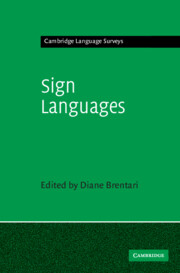Book contents
- Frontmatter
- Contents
- List of figures
- List of tables
- List of contributors
- List of sign language abbreviations
- Notational conventions
- 1 Introduction
- I HISTORY AND TRANSMISSION
- 2 Transmission of sign languages in Northern Europe
- 3 Transmission of sign languages in Latin America
- 4 Transmission of sign languages in the Nordic countries
- 5 Transmission of sign languages in Mediterranean Europe
- 6 Transmission of sign languages in Africa
- 7 Transmission of Polish sign systems
- II SHARED CROSSLINGUISTIC CHARACTERISTICS
- III VARIATION AND CHANGE
- Notes
- References
- Index
4 - Transmission of sign languages in the Nordic countries
from I - HISTORY AND TRANSMISSION
Published online by Cambridge University Press: 05 June 2012
- Frontmatter
- Contents
- List of figures
- List of tables
- List of contributors
- List of sign language abbreviations
- Notational conventions
- 1 Introduction
- I HISTORY AND TRANSMISSION
- 2 Transmission of sign languages in Northern Europe
- 3 Transmission of sign languages in Latin America
- 4 Transmission of sign languages in the Nordic countries
- 5 Transmission of sign languages in Mediterranean Europe
- 6 Transmission of sign languages in Africa
- 7 Transmission of Polish sign systems
- II SHARED CROSSLINGUISTIC CHARACTERISTICS
- III VARIATION AND CHANGE
- Notes
- References
- Index
Summary
Introduction
Scandinavia is the name of the three independent countries Denmark, Norway and Sweden; the term “the Nordic countries” includes also Finland and Iceland. The histories of these five countries are interwoven politically, linguistically and culturally with relations also to Greenland and the Faeroe Islands. As the present volume includes chapters with analyses of Danish Sign Language, Finnish Sign Language and Swedish Sign Language, the focus in this chapter will be on these three languages. But Danish Sign Language has influenced the sign languages used in Norway, Iceland, Greenland and the Faeroe Islands, so we will briefly sketch the role of Danish Sign Language in these other countries and regions at the end of the section on Danish Sign Language.
The Nordic Council for the Deaf was founded in 1907. One of its original aims was to create a common Nordic sign language, an aim that led to the compilation of the first sign dictionary in Finland (Hoyer 2005) and the second sign dictionary in Denmark. Discussions about common Nordic signs continued at the Nordic congresses for the deaf up through the century (Hoyer 2005), and as late as 1979 a sign dictionary was published in Denmark with some of the signs marked with an “N,” indicating that these signs were new and agreed upon by the Nordic deaf associations (Plum et al. 1979). However, these normative endeavors were not continued and were criticized not the least by deaf people themselves (Hoyer 2005).
- Type
- Chapter
- Information
- Sign Languages , pp. 74 - 94Publisher: Cambridge University PressPrint publication year: 2010
- 9
- Cited by

